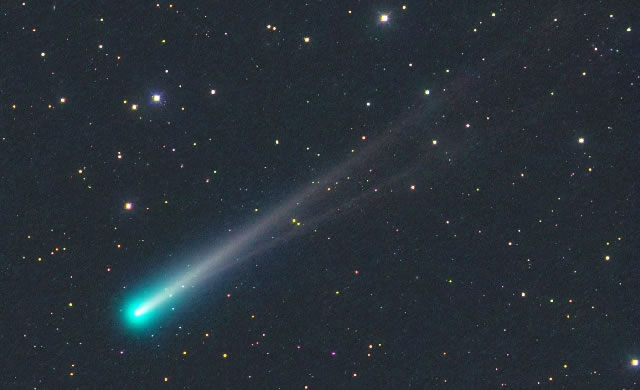
Credit: Michael Jäger
Gli astrofili sono sempre in prima linea per immortalare la Cometa ISON nel suo lungo tuffo verso il sole previsto per 28 novembre, data calcolata per questo incontro ravvicinato con il fuoco solare. Come aumenta il calore la cometa si illumina rivelando nuovi dettagli ogni giorno. In questa foto, scattata il 10 novembre da Michael Jäger di Jauerling, in Austria, ISON mostra una bellissima doppia coda.
Una delle due code è fatta di ioni. Si tratta di un sottile nastro di gas ionizzato spinto lontano dalla cometa grazie al vento solare. La coda di ioni filamentosi punta quasi direttamente lontano dal sole. L’altra coda è invece composta da polveri. Come Hansel e Gretel che lasciano le briciole di pane per segnare la strada di ritorno attraverso il bosco, ISON sta lasciando una scia di polvere dalla cometa che si muove attraverso il sistema solare. Rispetto alle molecole leggere presenti nella coda di ioni, i granelli di polvere della cometa sono più pesanti e più difficili per il vento solare da spargere in giro. La polvere tende a rimanere dove cade, pertanto, ripercorre l’orbita della cometa e non punta direttamente lontano dal sole come invece fa la coda di ioni. La Cometa ISON si sta muovendo attraverso la costellazione della Vergine bassa nel cielo orientale, prima dell’alba. Splendente come una stella di magnitudine 8°, ISON è ancora troppo debole per essere vista ad occhio nudo, ma con un obiettivo anche amatoriale è sempre più facile da osservare. Date di particolare interesse sono rispettivamente il 17 novembre e il 18, quando la cometa passerà vicina alla brillante stella Spica.
Amateur astronomers are getting a better look at Comet ISON as it dives toward the sun for a Nov. 28th close encounter with solar fire. As the heat rises, the comet brightens, revealing new details every day. This photo, taken Nov. 10th by Michael Jäger of Jauerling Austria, shows a beautiful double tail.
One tail is the ion tail. It is a thin streamer of ionized gas pushed away from the comet by solar wind. The filamentary ion tail points almost directly away from the sun. The other tail is the dust tail. Like Hansel and Gretel leaving bread crumbs to mark their way through the forest, ISON is leaving a trail of comet dust as it moves through the solar system. Compared to the lightweight molecules in the ion tail, grains of comet dust are heavier and harder for solar wind to push around. The dust tends to stay where it is dropped. The dust tail, therefore, traces the comet’s orbit and does not point directly away from the sun as the ion tail does. Comet ISON is currently moving through the constellation Virgo low in the eastern sky before dawn. Shining like an 8th magnitude star, it is still too dim for naked eye viewing, but an increasingly easy target for backyard optics. Amateur astronomers, if you have a GOTO telescope, enter these coordinates. Special dates of interest are Nov. 17th and 18th when the comet will pass the bright star Spica.
Source/Continue reading → SpaceWeather.com





















